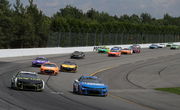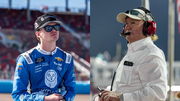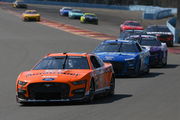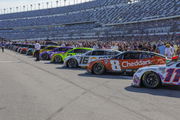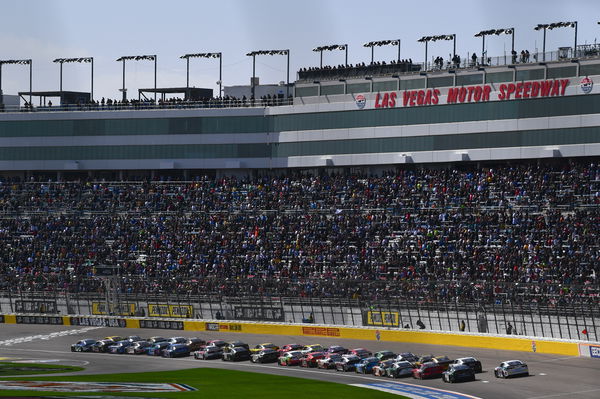
USA Today via Reuters
Mar 3, 2024; Las Vegas, Nevada, USA; NASCAR Cup Series driver Daniel Suarez (99) leads the field for the restart of the Pennzoil 400 at Las Vegas Motor Speedway. Mandatory Credit: Gary A. Vasquez-USA TODAY Sports

USA Today via Reuters
Mar 3, 2024; Las Vegas, Nevada, USA; NASCAR Cup Series driver Daniel Suarez (99) leads the field for the restart of the Pennzoil 400 at Las Vegas Motor Speedway. Mandatory Credit: Gary A. Vasquez-USA TODAY Sports
There were five separate tire problems when the NASCAR Cup Series made its way to Iowa Speedway for the first time in history. All at the 20-lap mark. Granted, the track was partially repaved, and some drivers weren’t used to its layout. But could it have been a coincidence? Were race teams setting up their cars incorrectly? And if the data given by Goodyear is accurate enough to avoid such pitfalls, how did such incidents not occur at the Goodyear tire test on May 28?
Christopher Bell, Austin Cindric, Ross Chastain, Ty Gibbs, and Tyler Reddick were among the drivers who were victims of tire problems in Iowa. Like the never-ending Goodyear-NextGen debate, this time around it has prompted RFK spotter TJ Majors to blame their respective teams for “self-induced” misery on the track, especially because other teams didn’t suffer the same fate.
ADVERTISEMENT
Article continues below this ad
Inconsistent tire wear at Iowa Speedway
Christopher Bell, Kyle Larson, and Brad Keselowski participated in the Goodyear tire test at Iowa Speedway’s.875-mile oval on May 28th. With temperatures 15 degrees cooler, the trio completed 50-lap runs all day without facing an issue. However, at the Toyota Save Mart 350, each team had 10 sets of tires to complete a 350-lap race, which meant they could change tires every 40 laps. Unfortunately, tire problems around the 20-lap mark meant teams had to re-evaluate how to set up their cars to make the tires last longer.
Responding to Freddie Kraft on the Door Bumper Clear podcast, TJ Majors, Brad Keselowski’s spotter for RFK Racing said, “We didn’t really have any tire issues. We weren’t having the overwear problem. I don’t think we were ever on the side of changing the air to be too low like a lot of the cars are. You can look at the cars that had problems and most of them are repeat offenders at some point.
“I think most of the tire problems like Freddy said were self-induced kind of. I know if you know that if Goodyear says the recommended is 30, there’s going to be some that are 28. But, it’s fast. I was a little worried about the track because in practice, everybody that got in the second lane, just lifted and dove right into the bottom. The second lane was really kind of sketchy in practice,” he continued.

via Imago
Featuring an 18-inch wheel diameter, shorter sidewall and wider contact patch, Goodyear’s NASCAR Next Gen tire closely resembles its high-performance tire that outfits passenger cars. The NASCAR Next Gen tire will take to the track on Feb. 20, at 2:30 p.m. ET for its regular season NASCAR Cup Series debut at the 64th annual DAYTONA 500. (The Marketing Arm images for Goodyear)
Don’t you think TJ Majors has a point? Plenty of drivers didn’t face any tire-related issues at Iowa Speedway, which meant that the issue was pressure- or setup-related. Goodyear underestimated the lap time by almost a second, meaning the recommended tire pressure had to be adjusted because cars were running faster in practice. As a result, teams that were setting up their cars below the recommended tire pressure to get more grip on the track were more susceptible to tire failures.
Trending
How does tire wear make NASCAR interesting?
Does anyone remember just how entertaining the race at Bristol Motor Speedway was earlier this year? The Food City 500 was not just one of the best short-track races of the Next Gen era, it might have possibly been one race in terms of pure entertainment in a long time! What made it such a blockbuster was the extreme tire wear cars faced throughout the race. With 500 laps to race, tires not lasting beyond 40 laps, and nine sets of tires per team, it will give you an idea of how big a role race strategy played in getting a result. This was the first time in Cup series history that only five cars finished on the lead lap.
Tires wore at such a rate that NASCAR issued teams an extra set. The lead changed hands a track record 54 times—often due to the leader managing tires and not wanting to run as fast as someone else. No one expected this entering the weekend.
ADVERTISEMENT
Article continues below this ad
“There’s nothing that stands out why the resin vs. PJ(1) did what they did,” said John Probst, NASCAR senior vice president and chief racing development officer, of the different traction compounds.

via Imago
NASCAR, Motorsport, USA Food City Dirt Race Apr 9, 2023 Bristol, Tennessee, USA General scene at the Bristol Motor Speedway Dirt Course. Bristol Bristol Motor Speedway Dirt Course Tennessee USA, EDITORIAL USE ONLY PUBLICATIONxINxGERxSUIxAUTxONLY Copyright: xRandyxSartinx 20230409_lbm_bs1_010
And that’s what makes NASCAR so entertaining! Drivers had to figure out just how much they could abuse their tires to make them last, while teams had to devise a strategy that gets their drivers a result. There was no ‘right’ approach, as drivers could opt for being aggressive and wearing down their tires by getting to the front or have a conservative approach and rise the ranks as the race progressed.
ADVERTISEMENT
Article continues below this ad
NASCAR has always been considered the ultimate test of both man and machine, simply because drivers had to outperform their peers while cars had to last the entirety of the race. That essence has been lost in recent years with cars becoming increasingly reliable, taking away a sense of unpredictability. For long-term NASCAR fans, high tire wear brings an edge-of-the-seat sort of entertainment that isn’t all too common in the sport anymore.
Do you think the NASCAR Cup Series should return to Iowa Speedway next year? Let us know in the comments!
ADVERTISEMENT
ADVERTISEMENT
ADVERTISEMENT
ADVERTISEMENT


